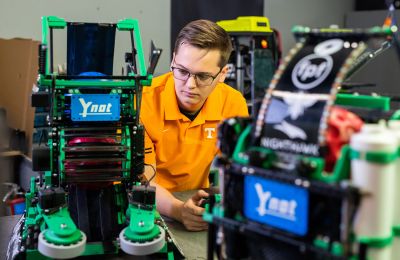“I like coming to campus a few times a week to see students, consult with other professors, and continue to advance the knowledge,” said McSween, now a Chancellor’s Professor emeritus. “My work is essential to me.”
Throughout all the work he’s done in his career—including the recent publication of an undergraduate textbook in planetary geoscience—the topic of Mars has consumed him.
McSween, a former US Air Force pilot, has participated in five NASA spacecraft missions, including the beloved Mars Opportunity rover, which unexpectedly lost contact with Earth in February 2019. He was a co-investigator for the NASA Mars Odyssey, Mars Pathfinder, Mars Global Surveyor, and Mars Exploration Rover missions. In 1999, he led a team of researchers that discovered geologic evidence from a meteorite indicating that water existed deep in Mars’s crust.
His career of collaborations with NASA has opened doors for many of his former students and colleagues throughout the years.
“UT graduates are now a significant part of NASA’s scientific mission,” he said.
When he started working at UT in 1977, there were only two planetary scientists on campus. Larry Taylor—who passed away in 2017 after a prolific career as a lunar rock scientist—was McSween’s only companion in that field. Today, nearly half of all EPS faculty spend some time doing work related to planetary sciences. Some of them, like Molly McCanta—who is leading a team of researchers in studying never-before opened moon rocks from the Apollo 17 mission—have been making considerable contributions to modern planetary science.
There is no other institution in the Southeast that does planetary sciences as well as we do. I am very proud of the work we do and how far we have come.
“I can hardly recognize this place from what it was 42 years ago when I first arrived,” McSween added. “I would even say it was a bit sleepy. Now it has evolved into this vibrant center, full of people engaged in the pursuit of knowledge.”
When McSween came to UT, he and a fellow graduate student from Harvard, Ed Stolper, were studying the origin of small meteorites so young that they could have come only from a nearby planet. McSween theorized that their homeland was Mars.

A few years later, NASA scientists found Martian atmosphere trapped in some of these rocks, and his theory was confirmed.
“When we started working on this, we only had two samples. Today we have 125 of them,” he said.
Fast-forward to 1997. McSween had been studying these meteorites for two decades already when NASA announced that Mars Pathfinder, a robotic rover, had traveled to the red planet, collected and analyzed rocks, and sent the information back to Earth.
But NASA didn’t have a scientist who knew enough about Martian soil to understand the data.
“That is how I joined that team. Someone in NASA said: ‘Call McSween: he thinks he knows something about Martian rocks,’” he laughed.
NASA’s rover missions presented more and more questions about Mars, and McSween slowly and steadily became a top expert in the field. Along the way, he received a number of prestigious accolades, including the Meteoritical Society’s Leonard Medal, the National Academy of Sciences’ J. Lawrence Smith Medal, and the Whipple Award from the American Geophysical Union Planetary Sciences Division. He was named a fellow of the American Academy of Arts and Sciences in 2008 and the Southeastern Conference Professor of the Year in 2013.
Even after his long career of scientific contributions, there is still a universe of questions to answer, including a very pressing one: will humans be able to reach Mars?
I think we will make it there, but I do not think this is something I will see in my lifetime. This is a very long-term project, and it is going to take time. The good news is that Mars is still out there, though. And it isn’t going anywhere.
 This story is part of the University of Tennessee’s 225th anniversary celebration. Volunteers light the way for others across Tennessee and throughout the world.
This story is part of the University of Tennessee’s 225th anniversary celebration. Volunteers light the way for others across Tennessee and throughout the world.







